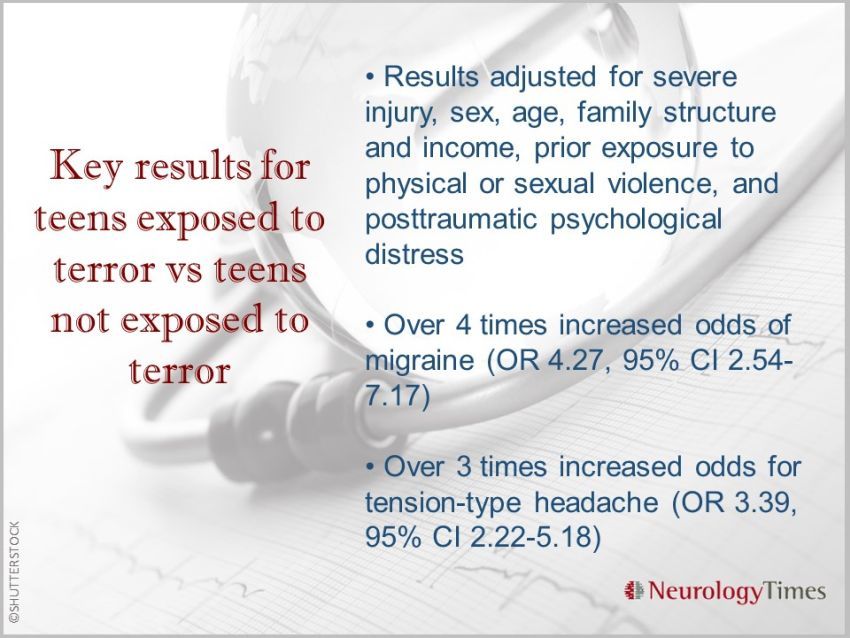Article
Terror Headaches in Teens Who Survived the Unthinkable
Author(s):
Teens survivors of terror attacks like mass shootings are 3 to 4 times more likely to suffer from frequent migraines than those who have not endured such experiences.
©FernandoCortes/Shutterstock

Key results for teens exposed to terror vs teens not exposed to terror

Teens survivors of terror attacks like mass shootings are 3 to 4 times more likely to suffer from frequent migraines and tension-type headaches than teens who have not endured such experiences, according to a study published in the January issue of Neurology.1 The study comprised teen survivors of a mass shooting in Norway, but the authors note that the findings could apply to other young survivors of terror, such as those in war zones, and those exposed to gun violence in their communities or violence at home in their families.
“Exposure to terror and other extreme violence increases the risk of recurrent or chronic headache complaints, over and above the effect of psychological distress and other known risk factors. Emergency preparedness planning, surveillance, and interventions may need to address survivors’ headaches to hinder chronification and to facilitate recovery,” wrote first author Synne Ãien Stensland, MD, PhD, of the Norwegian Centre for Violence and Traumatic Stress Studies and Oslo University, and colleagues.
Beyond the obvious physical danger and psychological distress posed by terror attacks, the lingering effects of such events on physical health remain relatively unknown. However, some research suggests that life-threatening terror events may increase susceptibility to chronic problems such as headache and migraine.
To investigate the issue, researchers studied survivors of a mass shooting that took place on July 22, 2011, when a lone gunman opened fire at a summer camp for teens on the Utøya islet in Norway, killing 69 people and severely wounding 33. Many survivors witnessed the atrocities, and many risked hypothermia and drowning when they tried to escape. The majority lost friends.
The study included 213 survivors, with a mean age of 17.7 years; 49% were male and 6% had been severely injured in the attack. Researchers matched survivors with 1704 teens who had not experienced the attack and who were drawn from a general health study of teens in Norway, the Young-HUNT3 study. Survivors were interviewed 4 to 5 months after the mass shooting using a validated questionnaire. Follow-up interviews were done at 1.5 years and about 3 years after the attack. Interviewers also assessed the need for health or psychological intervention and provided referrals as necessary.
Key results for teens exposed to terror vs teens not exposed to terror:
• Over 4 times increased odds of migraine (OR 4.27, 95% CI 2.54-7.17)
• Over 3 times increased odds for tension-type headache (OR 3.39, 95% CI 2.22-5.18)
• Results adjusted for severe injury, sex, age, family structure and income, prior exposure to physical or sexual violence, and posttraumatic psychological distress
The authors noted that the increased risk of headache among survivors was largely due to increased frequency of persistent weekly and daily migraine and tension-type headache. They hypothesized that exposure to terror could lead to central sensitization and the development of chronic migraine and headaches. Because childhood and adolescence represent a critical development period for the brain, children and teens may be particularly vulnerable.
However, due to its design, the study cannot prove that exposure to terror causes increased headaches. Also, the study could not directly evaluate whether the headaches were related to head injury or acute psychological distress. Further studies are needed to clarify these points and explore underlying mechanisms.
Take Home Points
1. Finding from a study of teen survivors of a mass shooting in Norway indicate that the survivors were over 4 times more likely to suffer from migraines and over 3 times more likely to suffer from tension-type headaches than teens who did not experience the attack.
2. The increased risk of headache among survivors was largely due to increased frequency of persistent weekly and daily migraine and tension-type headache.
3. Exposure to terror could lead to central sensitization and the development of chronic migraine and headaches, especially during the critical developmental period of childhood and adolescence, but more research is needed to understand the underlying mechanisms.
References:
1. Stensland SÃ, Zwart JA, Wentzel-Larsen T, et al. The headache of terror: a matched cohort study of adolescents from the Utøya and the HUNT Study. Neurology. 2018;90:e111-e118.




